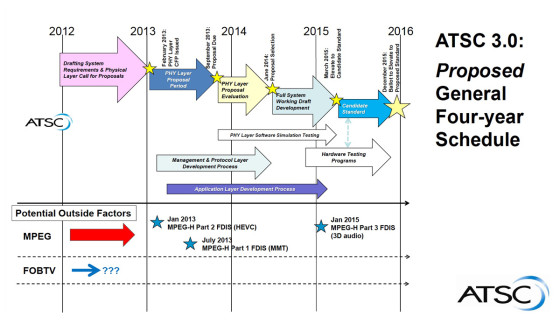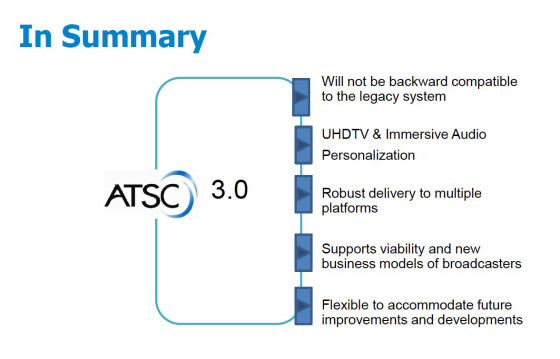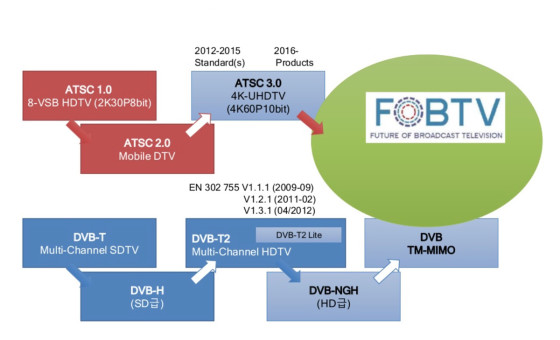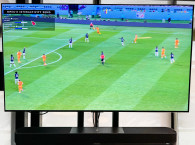As recently confirmed by the Advanced Television Systems Committee (ATSC) consortium, the process to develop the next-generation ATSC 3.0 broadcast standard has evolved and the first of five components within the Physical Layer transmission standard portion of ATSC 3.0 have been confirmed for ATSC “Candidate Standard” status and the full ATSC 3.0 standard should be finalized before the end of 2015.

Image courtesy of ATSC. Jim Kutzner/PBS Skip Pizzi/NAB
Announced in May 2015 by the ATSC Technology Group, the “System Discovery and Signaling” technology attained Candidate Standard status, meaning that the process for approving the so-called “bootstrap signal” piece of the Physical Layer of ATSC 3.0 is now officially under way. ATSC officials expect core elements of the physical layer, which include its modulation system, error correction algorithms, constellations, and more, to be approved soon, following current field trials.
The importance of ATSC 3.0 as a terrestrial television broadcast standard capable of advanced functionality in the digital era cannot be understated in the sense that it will be the pathway that over-the-air broadcasters will use for the foreseeable future to deliver UHD content, immersive audio, and more, to various types of digital viewing platforms. For information on the immersive audio demonstrations promoted at NAB 2015 see this post.
With these critical steps, “the Candidate Standard process for ATSC 3.0 is officially under way,” as stated by ATSC President Mark Richer. The ATSC is in the process of developing the next-generation ATSC 3.0 terrestrial television broadcast standard with advanced performance and functionality made possible by new technologies and strategies. This next-generation standard must provide improvements in performance, functionality and efficiency that are significant enough to warrant the challenges of a transition to a new system, directly transitioning from the current ATSC digital HDTV standard and effectively leapfrogging ATSC 2.0.
The bootstrap signal for ATSC 3.0 transmission will remain a Candidate Standard for nine months while prototype equipment may be built and tested in advance of balloting for the entire system. The TG3 Candidate Standard ballot for this portion of the Physical Layer was issued April 2015. “Simply put, the bootstrap is a low-level signal that tells a receiver to decode and process wireless services multiplexed in a broadcast channel. It’s designed to be a very robust signal and detectable even at low signal levels,” explained Richer.
The bootstrap signal provides a universal entry point into a broadcast waveform. It employs a fixed configuration (such as sampling rate, signal bandwidth, subcarrier spacing and time-domain structure) known to all receiver devices and carries information to enable processing and decoding the wireless service associated with a detected bootstrap signal, as well as a flag which indicates that an Emergency Alert is in effect.
“Many other services, at least some of which have likely not yet even been conceived, could also be provided by a broadcaster and identified within a transmitted signal through the use of a bootstrap signal associated with each particular service. This new capability ensures that broadcast spectrum can be adapted to carry new services in the years ahead,” Richer said.

ATSC 3.0 Field Tests
Digital over-the-air ATSC 3.0 signals are being field tested this summer. Under an experimental broadcast license from the FCC, Tribune Broadcasting’s WJW-TV is providing a TV transmitter, tower and 6-MHz channel for the ATSC 3.0-related field testing in Cleveland conducted since mid-May by LG Electronics, its Zenith R&D Lab, and GatesAir.
These real-world field tests represent an important milestone in the collaborative effort by LG, GatesAir and Zenith to develop core technologies behind the new ATSC 3.0 Standard. In fact, their innovations are expected to be used in the majority of the baseline Physical Layer transmission system, which is moving toward ATSC Candidate Standard status this summer.
In Cleveland, expert viewers visited a number of locations, witnessing how the more robust TV system will attract mobile viewers, connect viewers with Internet content, reach those in difficult reception locations, and delight owners of future 4K Ultra High-Definition TV sets with pristine 4K content delivered over-the-air using the new ATSC 3.0 standard.
The system being tested in Cleveland – dubbed “Futurecast” by proponents GatesAir, LG and Zenith – is a leading contributor to the effort to develop a next-generation ATSC 3.0 broadcast standard. Like similar field tests last fall in Madison, Wis., the Cleveland results are very encouraging. More than 75,000 pieces of additional data collected by engineers in the North Coast tests show how ATSC 3.0 will be able to deliver 4K Ultra HD content and two robust mobile TV streams in a single 6-Megahertz channel, while optimizing indoor reception and offering unparalleled spectrum efficiency.
Experts report that results in Cleveland are even more encouraging than the previous Wisconsin tests, with improved signal acquisition for mobile TV reception in fast-moving vehicles and at locations ranging from downtown’s concrete canyons to suburban and rural areas 50 miles from the transmitter.
“We’re pleased to play an integral role in the future of TV broadcast technology, putting an unused transmitter and vacant channel to use so that the proposed transmission system could be tested throughout the day and night. These initial field test results show that ATSC 3.0 technologies are real and can deliver real benefits to broadcasters and viewers alike,” said John Cifani, chief engineer of WJW-TV, the local Fox affiliate.
The Futurecast physical layer technologies are designed to provide the optimized combination of broadcasting capabilities for fixed, portable and mobile use. Flexible parameters allow broadcasters to mix diverse services – from fixed 4K reception to deep-indoor handheld reception to high-speed mobile reception – in a single RF channel with maximum efficiency.
“Our technology is designed to fully meet broadcaster requirements for ATSC 3.0 and advance the goal of moving rapidly to next-generation broadcasting. Whether watching from deep inside a building or along the Lake Erie lakefront, field test results show that our ATSC 3.0-enabling technology performs exactly as expected,” said Dr. Skott Ahn, President and Chief Technology Officer, LG Electronics.
“This means that broadcasters can look forward with confidence to reaching even more viewers with traditional television, with new Internet-based content, and with new money-making interactive services and advertising capabilities,” he said.
Rich Redmond, Chief Product Officer for Gates Air, adds, “Not only will reception be improved, but the advanced IP-based distribution and mobile broadcasting capabilities of ATSC 3.0 will shine through in times of emergency. Our collaborative innovations will support industry-wide efforts to evolve over-the-air business models, support next-generation warning systems and extend the reach of digital TV across greater populations.” Redmond adds that this includes leveraging AWARN (the Advanced Warning and Response Network) to deliver broadcast emergency announcements to TV sets and mobile devices containing rich media, maps, graphics, video, text, and audio.”
In addition to participating in field testing of ATSC 3.0 enabling technologies, expert viewers witnessed advanced emergency alerting capabilities thanks to a demonstration hosted by local CBS affiliate WOIO-TV, a Raycom Media station and member of the Pearl TV broadcast technology partnership. AWARN will capitalize on the robust transmission and improved mobile and fixed reception promised by ATSC 3.0, according to WOIO-TV General Manager Dominic Mancuso.
“Local broadcasters are vital links to our viewers here in Cleveland and across the country. Our viewers know that they can trust us to have the latest information in times of public safety emergencies. With ATSC 3.0 and AWARN, the public won’t be dependent on Internet or local phone service,” he said.

Mark Richer www.atsc.org
Redefining Broadcasting’s Future
Expected to redefine TV broadcasting for decades to come, the next-generation broadcast television standard will require higher capacity to deliver 4K Ultra-High-Definition services, robust reception on mobile devices and improved spectrum efficiency. The increased payload capacity of the physical layer combined with HEVC encoding will allow broadcasters many more options when planning their broadcast service offerings.
Designed for easy extension to various current and future transport formats, the LG/GatesAir/Zenith solutions optimize efficiency for the most-used data formats (Internet Protocol, Transport Stream) via customized stream compression.
The system supports single-frequency networks and/or multiple transmitters, and its use of a single RF transmission’s flexible physical layer profile assures optimum quality of service. The system is designed to support evolution to future broadcast systems even beyond ATSC 3.0.
Equally significant, the superior RF approach of the proven Futurecast system addresses the co-channel and adjacent-channel interference challenges related to the anticipated UHF spectrum repacking.
Development of ATSC 3.0 technologies represents the latest collaboration among LG, Zenith and GatesAir, co-inventors of the transmission system behind the ATSC A/153 Mobile Digital TV Standard, adopted by the industry in 2009. Zenith invented the core transmission system at the heart of today’s ATSC A/53 Digital Television Standard, approved by the Federal Communications Commission in 1996.
www.atsc.org







